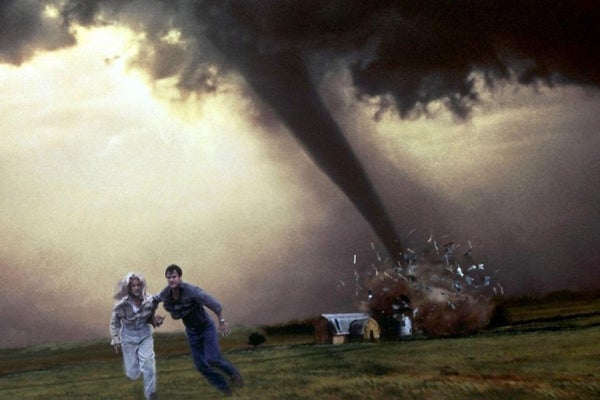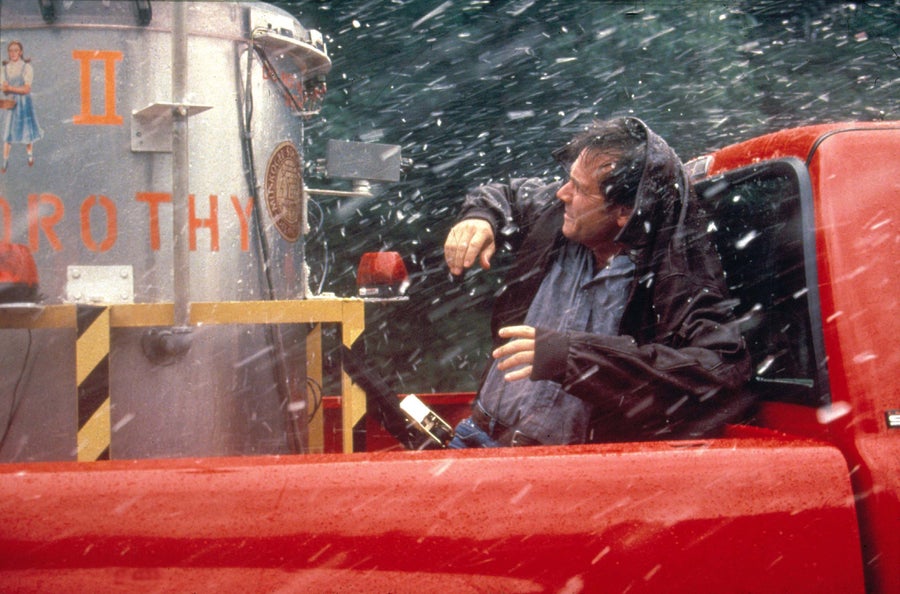Between Twister and Twisters, Tornado Science Has Improved a Lot in Three Decades

Between Twister and Twisters, Tornado Science Has Improved a Lot in Three Decades
Three decades of tornado science research is now at play in the new summer flick Twisters

Helen Hunt and Bill Paxton as their characters Jo and Bill Harding in the 1996 movie Twister.
Universal Pictures/Maximum Film/Alamy Stock Photo
“Dorothy” was deliberately fed to an Oklahoma F5 tornado about 30 years ago in the classic disaster movie Twister. The film followed storm-chasing scientists trying to use that special apparatus (a meteorological device containing hundreds of sensors and named after the tornado-jockey ingenue in The Wizard of Oz) to understand the inner workings of one of nature’s most fearsome phenomena. Now its just released stand-alone sequel, Twisters, follows another band of storm chasers who want to actually disrupt and dissipate these monster phenomena with today’s technology and knowledge.
Contrasting the two films shows how much tornado science has changed since the original flick, which featured radar and computer technologies that are now outdated. “We’ve come a long way since [Twister],” says Elizabeth Smith, a research meteorologist at the National Oceanic and Atmospheric Administration Administration’s National Severe Storms Laboratory (NSSL). And much of this progress has come through what she calls “the sum total of incremental change,” not singular projects like those depicted in the original movie. Some advances since then have in the decades transformed fiction into reality, enabling the latest film to explore even greater possibilities in managing and responding to dangerous weather events.
In the 1996 original, Helen Hunt’s character, Jo Harding, wanted to increase the warning times for tornadoes from three to 15 minutes by getting data from inside a funnel cloud to better understand how they work. And over the decades since, this science-fiction dream has turned into reality. “Now, when we issue a warning, the average lead time is 15 minutes,” says Harold Brooks, a senior research scientist at the NSSL. Though this may seem like a minor increase in the grand scheme of things, it offers considerably more time for people to reach shelter.
On supporting science journalism
If you’re enjoying this article, consider supporting our award-winning journalism by subscribing. By purchasing a subscription you are helping to ensure the future of impactful stories about the discoveries and ideas shaping our world today.
This improvement stems from a variety of new technologies, including more detailed radar readings and more powerful computers. But Smith says the most crucial development is computer models that can render storms in far greater detail—and can process observations much more quickly and accurately to better predict what those storms will do.
Early work in modeling focused on building a digital rendering of a storm from observational data—akin to Dorothy’s mission. But today’s tornado simulations are actually displaying never-before-observed aspects of the structure of tornadoes across different simulations. Storm chasers have later validated these phenomena in the field. “Instead of trying to go out and sample something to represent in the model, the opposite is now happening,” Smith says. “That’s a huge paradigm shift.”

Bill Paxton’s character Bill Harding attempts to prepare the “Dorothy” instrument package for deployment into a tornado in the 1996 movie Twister.
Moviestore Collection Ltd/Alamy Stock Photo
Modern forecast models sometimes even predict tornado touchdowns more than an hour in advance. This extended warning time isn’t always helpful, though. “People tend to prioritize other activities over immediate safety with one to two hours of advance notice, which isn’t the reaction we want,” says Sean Waugh, a research scientist at the NSSL. A 2011 study found through public surveys that about 30 minutes is the preferred warning time, balancing urgency with enough lead time to get to safety.
This improved computer modeling means the National Weather Service’s Storm Prediction Center, which issues tornado watches and warnings, can pinpoint locations—instead of issuing the old county-wide alerts that often reached people who were far away from any tornado threat. By reducing false alarms with more precise warnings, these innovations help maintain public alertness. And now forecasters are experimenting with advanced computer techniques, such as machine learning, in the hopes that they can analyze large amounts of data even more quickly and precisely to further improve warning times and accuracy.
Observational tornado research has also shifted to focus on storms’ three-dimensional structures at a larger scale. Key technologies such as lidar (light detection and ranging) have become essential. These tools enable researchers to map the ever changing and complex structures of the larger storms that produce tornadoes to try to understand why similar environmental conditions might trigger a tornado in one storm but not in another nearby. This complexity highlights the limitations of collecting individual data points within storms (an approach that was dramatically portrayed in Twister but is now less useful). “There’s so much going on in such a small space, and we need to see all of it at once to be able to understand what’s going on,” Waugh says.
The scientists in the new movie go beyond the goal of improving warnings to explore the idea of possibly disrupting a tornado. In reality, however, the science behind such a feat remains out of reach. The concept of deliberately neutralizing a tornado is theoretically possible, Brooks says, but the energy contained within one is immense; disrupting a real twister would require an input of energy on a scale that is not physically or practically feasible. “In terms of energy, a tornado releases about the equivalent of an atomic bomb every second, and a thunderstorm can release the energy of tens of hydrogen bombs per second,” he says.
Even if humans could somehow take out an incoming twister, the atmospheric conditions that gave rise to the storm would persist—potentially leading to the immediate formation of another one. Relatively speaking, “a tornado is nothing more than a burnt fart in the storm,” Brooks says. Waugh says neutralizing one is a tempting notion to explore, but ultimately, “humans are not meant to play God with these types of natural phenomena. Our focus should instead be on building resiliency and enhancing protection for populations in the face of such events.”
Though the science in the new film is, in some aspects, far-fetched, the very real and staggering technological and scientific achievements of modern meteorological science would have seemed like science fiction to Jo Harding and her team. And those advances aren’t just of importance to meteorological science or Hollywood spectacle but have also saved countless lives. “This work is impactful to everyday life,” Smith says,” and that keeps you grounded.”




